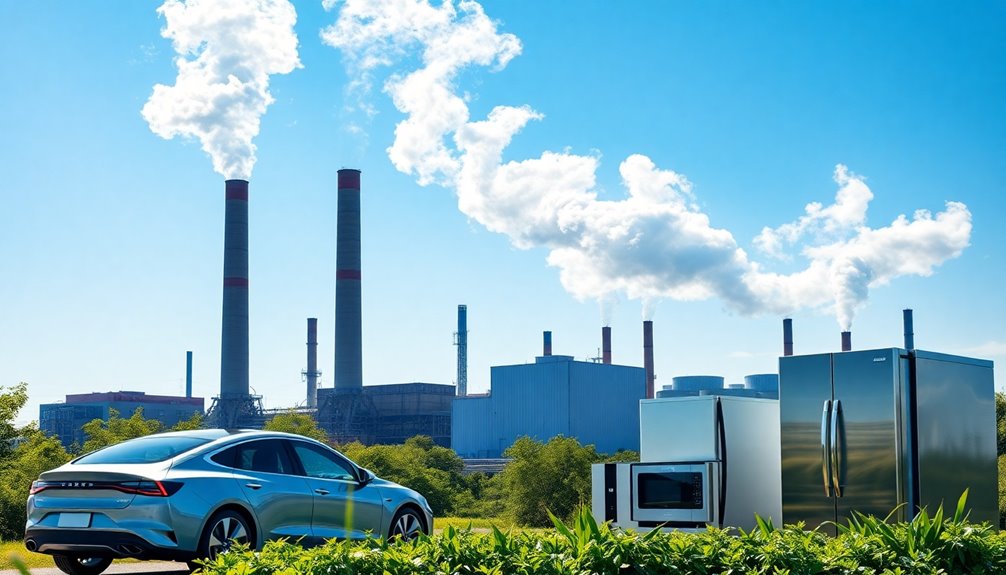Waste gases from industries can definitely power consumer goods, cutting down on fossil fuel use. By transforming emissions from processes like mining and manufacturing, companies are turning pollution into valuable energy. Technologies like the Power Oxidizer convert these waste gases into power, creating new revenue streams and improving efficiency. This not only helps meet strict regulations but also reduces carbon footprints. If you're curious about how this shift is shaping the future of energy, there's more to explore.
Key Takeaways
- Waste gases from industrial processes can be converted into energy, providing a sustainable alternative to fossil fuels for powering consumer goods.
- Technologies like the Power Oxidizer enable efficient conversion of waste gases into usable energy while reducing harmful emissions.
- Utilizing waste gases can lower operational costs and create new revenue streams by selling excess energy generated on-site.
- The transition to waste gas-powered energy supports the reduction of carbon footprints and helps meet stringent emissions regulations.
- Ongoing research and grants are promoting innovations that enhance the viability of waste gases as renewable energy sources for various applications.

As industries continue to seek sustainable solutions, waste gases have emerged as a promising power source that can transform pollution into energy. These gases, generated from various industrial processes like mining, oil and gas operations, and manufacturing, pose significant environmental threats due to their high greenhouse gas content. However, with the right technologies, you can turn these emissions into a valuable resource, reducing both environmental impact and operational costs.
Landfills and coal mining are notable sources of methane gas, while refineries and chemical plants contribute waste gases that can lead to air pollution and global warming. By utilizing waste gases, you can significantly cut down your carbon footprint and combat the negative effects of industrial emissions. Technologies like the Power Oxidizer, developed by Dresser Rand and Ener Core, can convert these gases into energy, generating power and steam while minimizing harmful emissions. The Power Oxidizer technology not only helps in meeting strict emissions regulations but also enhances the overall efficiency of energy production.
The economic benefits of harnessing waste gases are compelling. By converting waste gases into energy, you not only create new revenue streams by selling excess energy but also reduce your operational costs. On-site power generation allows you to rely less on external energy sources, boosting your operational efficiency. Additionally, flare gas recovery serves as a cost-effective method for energy utilization, further enhancing profitability.
Harnessing waste gases not only generates new revenue streams but also significantly lowers operational costs.
As you consider future developments, innovations in waste gas utilization are set to decarbonize industries. Grants and research initiatives are paving the way for cleaner energy solutions, aiming to phase out emissions from industrial processes entirely. Biogas and associated petroleum gas are becoming increasingly recognized as renewable energy sources that can power both industrial processes and consumer goods.
Frequently Asked Questions
How Are Waste Gases Converted Into Usable Energy?
To convert waste gases into usable energy, you can utilize methods like gasification and pyrolysis.
In gasification, the waste is heated in a low-oxygen environment, producing syngas, which you can use for electricity or fuel.
Pyrolysis breaks down organic materials without oxygen, yielding biochar and bio-oil.
These processes not only generate energy but also minimize emissions, making them efficient alternatives to traditional waste disposal methods while promoting sustainability.
What Industries Produce the Most Waste Gases?
Did you know that fossil fuel combustion contributes to 75% of global greenhouse gas emissions?
When you look at industries, coal-fired power plants, cement production, and steel manufacturing stand out for producing significant waste gases.
The chemical industry also plays a role, releasing emissions during various processes.
Beyond these, agriculture and transport sectors contribute to greenhouse gases, making it crucial for you to consider cleaner alternatives in your everyday choices.
Are There Environmental Risks Associated With Waste Gas Utilization?
Yes, there are environmental risks associated with waste gas utilization.
You need to consider potential water contamination during the conversion processes, which can affect local ecosystems.
Also, some technologies might require significant water resources, putting stress on those supplies.
While waste gas can reduce CO₂ emissions, it's important to remember that certain processes still emit greenhouse gases.
You should weigh these risks against the benefits of moving away from fossil fuels.
How Does This Technology Compare to Renewable Energy Sources?
When you compare waste gas conversion technology to renewable energy sources, both have unique advantages.
Waste gas utilization can significantly reduce emissions, but it's currently more energy-intensive and costly.
On the other hand, renewable energy provides minimal emissions and is becoming increasingly cost-effective.
While waste gases offer a pathway to a circular economy, the efficiency and scalability of renewables make them a compelling choice for sustainable energy solutions moving forward.
What Is the Cost of Implementing Waste Gas Power Systems?
Implementing waste gas power systems can be pricey. You're looking at technological costs around $8/kg for CO2-derived products, which is significantly higher than fossil fuel alternatives.
Economic challenges, like the high conversion costs and limited hydrogen supply, make widespread adoption tough. While the potential for cost reduction exists through advancements and growing demand, scalability and infrastructure investments are crucial to making these systems more viable and competitive in the market.
Conclusion
Imagine a world where the very gases we discard become the energy that powers our daily lives. It's not just a possibility; it's happening right now. By harnessing waste gases from industries, you could charge your devices, heat your homes, and even fuel your cars—all while reducing reliance on fossil fuels. Coincidentally, this innovation not only helps the environment but also brings us closer to a sustainable future. Isn't it amazing how our waste could lead to a greener tomorrow?









